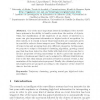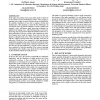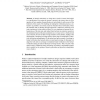42 search results - page 7 / 9 » Concerning the Ordering of Adaptive Test Sequences |
TNN
1998
13 years 7 months ago
1998
—Adaptive resonance theory (ART) describes a family of self-organizing neural networks, capable of clustering arbitrary sequences of input patterns into stable recognition codes....
IWINAC
2011
Springer
12 years 10 months ago
2011
Springer
Abstract. One of the more important issues in intelligent video surveillance systems is the ability to handle events from the motion of objects. Thus, the classification of the tr...
ISMIR
2001
Springer
13 years 11 months ago
2001
Springer
In this paper, the problem of processing audio signals is addressed in the context of query-by-humming systems. Since singing is naturally used as input, we aim to develop a front...
CHARME
2003
Springer
13 years 11 months ago
2003
Springer
In formal verification, we verify that a system is correct with respect to a specification. Even when the system is proven to be correct, there is still a question of how complete ...
CCGRID
2010
IEEE
13 years 2 months ago
2010
IEEE
This paper discusses our experience in building SPIRE, an autonomic system for service provision. The architecture consists of a set of hosted Web Services subject to QoS constrain...



